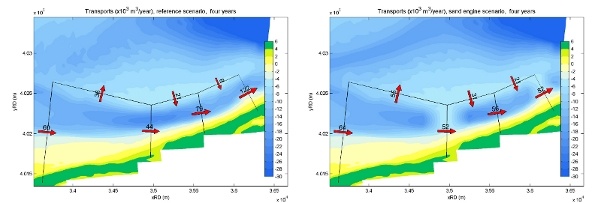Planning and design
The coast at Onrustpolder is dominated by a complex interaction of the Roompot, Onrust, Roompot-Hompels and Oude Roompot channels, and the Eastern Scheldt storm surge barrier. In previous studies, the erosion of the coast at Onrustpolder had been shown to principally be caused by the migration of the Onrust tidal channel towards the coast at Onrustpolder.
Feasibililty
In order to aid the development of the conceptual design of the sand engine in the Onrust channel, a numerical model was set up of the area surrounding the Onrust channel to give insight into flow, wave and sediment transport patterns. In particular the model was used to answer the following questions:
- What is the current sediment transport pattern in area of interest and how is this pattern affected by waves?
- What will the effect of the sand engine nourishment be on the sediment transport pattern in the Onrust channel.
- How will the sand engine nourishment affect the sediment transport pattern in the surrounding area?
- Will the sand engine nourishment achieve the desired effect of allowing the shoal to move towards shore or move faster towards shore?
Through a series of numerical model simulations, the autonomous flow, wave, transport patterns and morphology were compared to those in simulations in which a sand engine had been placed in the Onrust channel. The absolute and relative results of these simulations were analyzed to answer the four design questions.
What is the current sediment transport pattern in area of interest and how is this pattern affected by waves?
On a large scale the current flow and sediment transport pattern shows flood dominance in the Roompot, Roompot-Hompels and Onrust channels and ebb dominance in the Oude Roompot channel. At the western end of the Onrust channel, at the intersection with the Roompot channel, tide-drive sediment transports lead to a convergence zone and the development of an ebb delta. Wave-driven sediment transport along the coast to the south of the Roompot and Onrust channels is easterly directed and is in the same order as tidal-driven transport (~200,000m3 per year) at the start of the Onrust channel. Limited sediment exchange takes place between the Onrust channel and the Onrust shoal. Wave effects increase the sediment exchange between the Onrust channel and shoal, but do not affect the direction of net transport. The effect of waves on the large-scale transport pattern is limited, with the exception of the wave-driven transport along the coast and in the area to the north of the Roompot-Hompels channel.
What will the effect of the sand engine nourishment be on the sediment transport pattern in the Onrust channel?
The presence of the nourishments at the eastern and western ends of the Onrust channel lead to greater sediment transport gradients in the surrounding areas. As a consequence sedimentation takes place in the channel to the east and west of the nourishments and on the shoal to the north of the nourishments. The presence of the sand engine leads to enhanced sediment exchange between the Onrust channel and shoal, but in the current configuration this exchange leads to net loss from the channel to the shoal.
How will the sand engine nourishment affect the sediment transport pattern in the surrounding area?
The presence of the sand engine and the dredged channel in the Roompot-Hompels channels leads to a change in the net sediment transport pattern from weakly flood dominated transport to strongly ebb dominated transport at the intersection of the Roompot, Roompot-Hompels and Onrust channels.
Will the sand engine nourishment achieve the desired effect of allowing the shoal to move towards shore or move faster towards shore?
The nourishments in the Onrust channel will increase sediment deposition in the channel due to the redistribution of the nourishment sand. However, because wave-driven transport from the Onrust shoal to the Onrust channel is limited and the presence of the nourishments does not affect the tide-dominated sediment transport sufficiently, the current sand engine configuration will only have a limited effect of allowing the shoal to move faster towards shore (see the Figure below).

